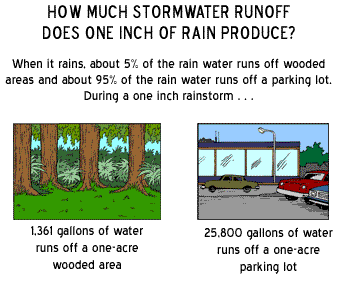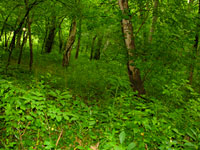Stormwater and Streams
 Prince William is a rapidly suburbanizing area with significant amounts of impervious surfaces. Impervious surfaces, areas covered with roads, parking lots, roofs and other surfaces, do not allow water to soak into the ground. The result is a significant increase in the volume of water that runs off the land when it rains, snows or sleets. Prince William is a rapidly suburbanizing area with significant amounts of impervious surfaces. Impervious surfaces, areas covered with roads, parking lots, roofs and other surfaces, do not allow water to soak into the ground. The result is a significant increase in the volume of water that runs off the land when it rains, snows or sleets.
Always on the move, water flows downhill over and through the land to the nearest waterway. From there, the water moves through Prince William's network of over 1,000 miles of creeks and rivers, which all eventually flow into the Potomac River and then to the Chesapeake Bay.
Water, the universal solvent, picks up pollutants as it moves across the land's surface, including fertilizers, pesticides, automobile emissions and other human byproducts. Soil particles, dislodged by the impact from raindrops hitting the ground and from sites cleared of vegetation, are carried to waterways with the moving stormwater. This increases the transfer of pollutants to waterways and moves fertile soils from the land to creeks, rivers and bays.
This has a dramatic impact on aquatic ecosystems. Sediments remain suspended in the water column and clear waters become murky. Eventually, sediment settles on the bottom and fills in spaces on the rocky bottoms of streams, eliminating the habitat for the aquatic creatures (food for fish, birds and others) that live under and around these rocks.
The sheer volume of water entering creeks and rivers is also a problem. The force generated by these large volumes of water tears vegetation from creek banks, scours creek bottoms and overwhelms the natural boundaries of the waterway. Stormwater moving across impervious surfaces picks up the heat stored in these surfaces. When stormwater enters the waterway and begins to flow downstream, effects from the heat have a cumulative impact.
Prince William is home to more than 400,000 people and still growing. Is it possible to balance our suburban land uses in ways that can ensure high quality waterways? Although stormwater program requirements include a variety of ecosystem and human health protection goals, conventional practices and technology are not meeting many of these goals.
 Communities are faced with the challenge of funding upgrades and refurbishing an ever-expanding network of stormwater infrastructure. Even more intimidating is the additional challenge of restoring satisfactory water quality conditions to local creeks and rivers. Communities are faced with the challenge of funding upgrades and refurbishing an ever-expanding network of stormwater infrastructure. Even more intimidating is the additional challenge of restoring satisfactory water quality conditions to local creeks and rivers.
These economic realities cannot be ignored and, in response, communities throughout the Chesapeake Bay watershed are beginning to implement Low Impact Development (LID) programs, which replace constructed fixes with techniques that mimic nature.
Traditional stormwater practices are geared toward structural enhancements such as pipes. LID focuses on systems that are modeled after nature and consider both natural and built components of the development site.
The first step in implementing LID techniques begins at the planning phase with an analysis of how water moves into and across the development site. This information helps planners, who want to make full use of the development site, understand how essential natural functions can be preserved and integrated into the site plan. The completed site blueprint recognizes natural resource values and integrates important save areas into the layout design.
 Conservation of existing resources is critical to success, but can't do the job alone. LID also seeks to minimize and disconnect impervious surfaces using a combination of techniques, including alternative construction materials and other design criteria. LID integrates many small, simple solutions throughout the development site. Conservation of existing resources is critical to success, but can't do the job alone. LID also seeks to minimize and disconnect impervious surfaces using a combination of techniques, including alternative construction materials and other design criteria. LID integrates many small, simple solutions throughout the development site.
Conserving sensitive natural features (valuable natural assets) is the foundation of the LID approach. Countywide watershed planning, including development of an open space management plan, would set the stage for productive LID efforts. Ultimately, choices in the types and amounts of practices used in LID designs will be up to the local community.
LID is helping forward-thinking communities balance the need to both address economic growth and protect the local environment. The Virginia Dept. of Conservation and the Chesapeake Bay Local Assistance Dept. are promoting LID as an alternative and supplement to existing stormwater programs. The LID approach offers Prince William an exciting opportunity for citizens, government and developers to make educated choices together. |